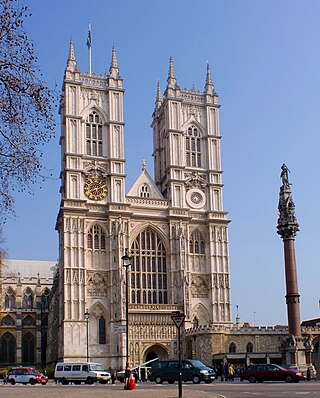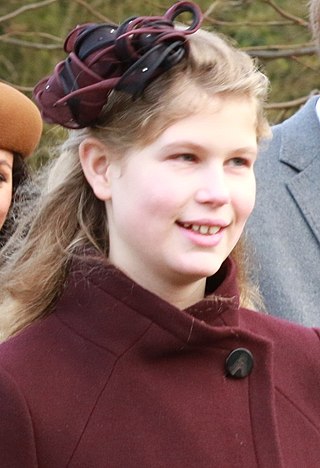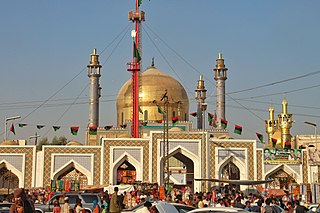Tomb of Phyllis Louise Lawrence is the tomb of an early 20th-century philanthropist in Karachi, named Phyllis Louise Lawrence. [1] It is situated in Gora Qabaristan, Karachi. [2]
Tomb of Phyllis Louise Lawrence is the tomb of an early 20th-century philanthropist in Karachi, named Phyllis Louise Lawrence. [1] It is situated in Gora Qabaristan, Karachi. [2]
The tomb was built by her husband, Sir Henry Staveley Lawrence, in her memory. [2] Located in a historical British-era graveyard, the mausoleum consists of a dome supported by six pillars. [2]
In 2007, restoration work replaced the original white marble with yellow stone. [2]
Phyllis Louise Lawrence, commonly referred to as Lady Phyllis, (August 24, 1868 – June 30, 1912) was a 20th-century philanthropist who worked to improve the health and education for Sindhi women. [2] She was proficient in Sindhi language. [3]
Lady Phyllis was also a known equestrian enthusiast. [2] [3] On June 30, 1912, a solo carriage ride resulted in her demise when her long hair got tangled in the carriage wheel spokes, leading to her being dragged until the horses stopped. [2] [3]
In the aftermath of her unexpected death, her spouse, a British colonial administrator in Karachi, constructed a marble tomb in her memory. [2] Phyllis Louise Lawrence Institute, named after her, was established in 1912 which is now part of the Cowasjee School of Midwifery at the Lady Dufferin Hospital. [2]

Karachi is the largest city in Pakistan and 12th largest in the world, with a population of over 20 million. It is situated at the southern tip of the country along the Arabian Sea coast. It is the former capital of Pakistan and capital of the province of Sindh. Ranked as a beta-global city, it is Pakistan's premier industrial and financial centre, with an estimated GDP of over $200 billion (PPP) as of 2021. Karachi is Pakistan's most cosmopolitan city, linguistically, ethnically, and religiously diverse cities, as well as one of the most socially liberal.

Sindh is a province of Pakistan. Located in the southeastern region of the country, Sindh is the third-largest province of Pakistan by land area and the second-largest province by population after Punjab. It is bordered by the Pakistani provinces of Balochistan to the west and north-west and Punjab to the north. It shares an International border with the Indian states of Gujarat and Rajasthan to the east; it is also bounded by the Arabian Sea to the south. Sindh's landscape consists mostly of alluvial plains flanking the Indus River, the Thar Desert in the eastern portion of the province along the international border with India, and the Kirthar Mountains in the western portion of the province.

Westminster Abbey, formally titled the Collegiate Church of Saint Peter at Westminster, is an Anglican church in the City of Westminster, London, England. Since 1066, it has been the location of the coronations of 40 English and British monarchs, and a burial site for 18 English, Scottish, and British monarchs. At least 16 royal weddings have occurred at the abbey since 1100.

The Taj Mahal is an ivory-white marble mausoleum on the right bank of the river Yamuna in Agra, Uttar Pradesh, India. It was commissioned in 1631 by the fifth Mughal emperor, Shah Jahan to house the tomb of his beloved wife, Mumtaz Mahal; it also houses the tomb of Shah Jahan himself. The tomb is the centrepiece of a 17-hectare (42-acre) complex, which includes a mosque and a guest house, and is set in formal gardens bounded on three sides by a crenellated wall.

Lahore is the second largest city in Pakistan after Karachi and 26th largest in the world, with a population of over 13 million. It is situated in the north-east of the country with River Ravi flowing north-west of the city. It is the capital of the province of Punjab, where it is the largest city. Lahore is one of Pakistan's major industrial and economic hubs. It has been the historic capital and cultural centre of the wider Punjab region, and is one of Pakistan's most socially liberal, progressive, and cosmopolitan cities.

Hyderabad is a city and the capital of Hyderabad Division in the Sindh province of Pakistan. It is the second-largest city in Sindh, and the eighth largest in Pakistan.

Lady Louise Alice Elizabeth Mary Mountbatten-Windsor is the daughter of Prince Edward, Duke of Edinburgh, and Sophie, Duchess of Edinburgh. She is the youngest niece of King Charles III. She was born 8th in line to the British throne and is now 16th as of 2023.

Sindhis are an Indo-Aryan ethnolinguistic group who speak the Sindhi language and are native to the Sindh province of Pakistan. The historical homeland of Sindhis is bordered by the southeastern part of Balochistan, the Bahawalpur region of Punjab and the Kutch region of Gujarat. Having been isolated throughout history unlike its neighbours, Sindhi culture has preserved its own uniqueness.

Mazar-e-Quaid, also known as Jinnah Mausoleum or the National Mausoleum, is the final resting place of Muhammad Ali Jinnah, the founder of Pakistan. Designed in a 1960s modernist style, it was completed in 1971, and is an iconic symbol of Karachi as well as one of the most popular tourist sites in the city. The mausoleum complex also contains the tomb of Jinnah's sister, Māder-e Millat Fatima Jinnah, as well as those of Liaquat Ali Khan and Nurul Amin, the first and eighth Prime Ministers of Pakistan respectively. The tomb of Sardar Abdur Rab Nishtar, a stalwart of the Muslim League from Peshawar, is also located there.

The Bibi Ka Maqbara is a tomb located in Aurangabad, Maharashtra, India. It was commissioned in 1660 by the Mughal emperor Aurangzeb's son prince Azam Shah in the memory of his loving mother Dilras Banu Begum. It bears a striking resemblance to the Taj Mahal, the mausoleum of Aurangzeb's mother, Mumtaz Mahal. Aurangzeb was not much interested in architecture though he had commissioned the small, but elegant, Pearl Mosque at Delhi. Bibi Ka Maqbara is the second largest structure that Aurangzeb has built, the largest being the Badshahi Mosque.

Phyllis Logan is a Scottish actress, known for playing Lady Jane Felsham in Lovejoy (1986–1993) and Mrs Hughes in Downton Abbey (2010–2015). She won the BAFTA Award for Most Promising Newcomer for the 1983 film Another Time, Another Place. Her other film appearances include Secrets & Lies (1996), Shooting Fish (1997), Downton Abbey (2019) and Misbehaviour (2020).

Hazrat Sayyid Usman Marwandi, popularly known as Lal Shahbaz Qalandar, was a Sufi saint and poet of present-day Pakistan and Afghanistan.

Lady Dufferin Hospital is district general hospital is located in Karachi, Sindh. Lady Dufferin Hospital to since on 1898, was named after the British peeress Lady Dufferin.
Pakistani architecture is intertwined with the architecture of the broader Indian subcontinent. The major architectural styles popular in the past were Temple, Indo-Islamic, Mughal and Indo-Saracenic architecture, all of which have many regional varieties. With the beginning of the Indus civilization around the middle of the 3rd millennium BC, for the first time in the area which encompasses today's Pakistan an advanced urban culture developed with large structural facilities, some of which survive to this day. This was followed by the Gandhara style of Buddhist architecture that borrowed elements from Ancient Greece. These remnants are visible in the Gandhara capital of Taxila.
Pakistani clothing refers to the ethnic clothing that is typically worn by people in the country of Pakistan and by Pakistanis. Pakistani clothes express the culture of Pakistan, the demographics of Pakistan, and cultures from Punjab, Sindh, Balochistan, Khyber Pakhtunkhwa, Gilgit-Baltistan, and Kashmir regions of the country. The clothing in each region and culture of Pakistan reflect weather conditions, way of living, the textiles and embroidery used and its distinctive style which gives it a unique identity among all cultures.
The cultural history of Karachi goes back at least five thousand years to the emergence of the Indus Valley Civilization in the third millennium BC. The early culture is mostly Neolithic with widespread usage of small cart implements and semi-precious stones. The many megalithic Arab graves around Karachi gave evidence towards megalithic movements of the Arabian Peninsula.

The Muhajir people are Muslim immigrants of various ethnic groups and regional origins, and their descendants, who migrated from various regions of India after the Partition of India to settle in the newly independent state of Pakistan. The term "Muhajirs" refers to those Muslim migrants from India, who settled in urban Sindh. The Muhajir community also includes stranded Pakistanis in Bangladesh who migrated to Pakistan after 1971 following the secession of East Pakistan in the Bangladesh Liberation War.

St Mary Magdalen Roman Catholic Church, Mortlake, is a Roman Catholic church in North Worple Way, Mortlake, in the London Borough of Richmond upon Thames. The church is dedicated to Jesus' companion Mary Magdalene. It is located just south of Mortlake High Street and the Anglican St Mary the Virgin Church. St Mary Magdalen's Catholic Primary School is just north of the churchyard.

The Tomb of Nur Jahan is a 17th-century mausoleum in Lahore, Pakistan, that was built for the Mughal empress Nur Jahan. The tomb's marble was plundered during the Sikh era in 18th century for use at the Golden Temple in Amritsar. The red sandstone mausoleum, along with the nearby tomb of Jahangir, tomb of Asif Khan, and Akbari Sarai, forms part of an ensemble of Mughal monuments in Lahore's Shahdara Bagh.

St Mary's Watford is a Church of England church in Watford, Hertfordshire, in England. It is an active church situated in the town centre on Watford High Street, approximately 25 kilometres (16 mi) outside London. St Mary's is the parish church of Watford and is part of the Anglican Diocese of St Albans. Thought to be at least 800 years old, the church contains burials of a number of local nobility and some noteworthy monumental sculpture of the Elizabethan and Jacobean eras.